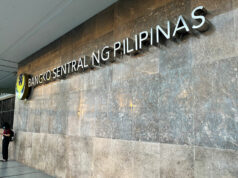
YIELDS on government securities (GS) traded at the secondary market fell last week after the auction result of reissued seven-year bonds and the central bank saying that an interest rate hike is unnecessary.
GS yields dropped by an average of 4.09 basis points (bps) week on week, based on PHP Bloomberg Valuation Service Reference Rates as of Sept. 15 published on the Philippine Dealing System’s website.
Yields fell across the board, with rates of the 91-, 182-, and 364-day Treasury bills (T-bills) going down by 3.28 bps (to 5.6225%), 2.26 bps (5.9641%), and 2.94 bps (6.1636%), respectively.
At the belly, rates of the two-, three-, four-, five-, and seven-year Treasury bonds (T-bonds) decreased by 1.76 bps (to 6.2098%), 3.51 bps (6.2231%), 6.08 bps (6.2342%), 8.17 bps (6.2566%), and 7.14 bps (6.3440%).
Yields at the long end also dropped. The rate of the 10-year papers went down by 4.96 bps to 6.4440%, followed by the 20- and 25-year T-bonds, which declined by 2.55 bps and 2.3 bps to 6.6277% and 6.6321%, respectively.
Total GS volume reached P13.99 billion on Friday, slightly higher than the P13.63 billion recorded on Sept. 8.
“Yields were lower on a weekly basis as buyers of duration emerged after the BTr (Bureau of the Treasury) partially awarded the recent seven-year reissuance,” said ATRAM Trust Corp. Chief Investment Officer Alessandra P. Araullo in a Viber message.
“Investors took the opportunity to buy bonds especially at the long end, as they have priced in that policy rates will remain unchanged in the next meeting. At the same time, investors considered the next 10-year auction and the risk that the BTr might cap the award again, and limit the supply offered at a favorable price compared to the secondary market levels,” added Ms. Araullo.
Last Tuesday, the BTr raised P9.88 billion, below the planned P30 billion via its offer of reissued seven-year T-bonds, which have a remaining life of six years and 10 months.
The notes attracted total tenders worth P57.79 billion, almost twice the amount on offer.
The reissued seven-year bonds fetched an average rate of 6.37%, higher by 4.2 basis points than the 6.328% quoted for the papers when they were first offered on July 26, 2022.
Jonathan L. Ravelas, senior adviser at Reyes Tacandong & Co., said in a Viber message that the announcement of the Bangko Sentral ng Pilipinas (BSP) to maintain its policy rate could have also affected the trading result last week.
Asked about what has driven the GS movement, Mr. Ravelas pointed to pronouncements by the BSP to keep rates unchanged amid upside risks to inflation.
BSP Governor Eli M. Remolona, Jr. said last week that the Monetary Board would not resume its monetary tightening despite quicker inflation driven by “supply shocks.”
Preliminary data from the Philippine Statistics Authority (PSA) showed annual headline inflation quickened to 5.3% from 4.7% in July. However, this was slower than the 6.3% print a year ago.
Philippine headline inflation in August was the fastest in two months or since the 5.4% print in June, amid a spike in the prices of rice, vegetables and fuel, the statistics agency said.
In the January-to-August period, changes in the consumer price index averaged 6.6%, higher than the Bangko Sentral ng Pilipinas’ forecast of 5.6% and the 2-4% target range for the year.
The BSP has kept its key policy rate at a near 16-year high of 6.25% for the last three meetings. It has hiked borrowing costs by 425 basis points (bps) from May 2022 to March 2023.
For Ms. Araullo, investors this week are excited about the awaited monetary board meeting of the BSP and the US Federal Reserve.
“Given that the market has already priced in that local policy rates will remain unchanged in the medium term, trading in the GS space may remain rangebound should there be no surprise announcements during the meeting,” said Ms. Araullo.
Ms. Araullo added that a hawkish pause from the BSP is still being considered by GS investors given the recent weakening of the peso, and reinflationary concerns driven by food and transport prices.
“This has also caused the downtrend of market volume in the GS space as players maintain their defensive stance,” Ms. Araullo said. — Lourdes O. Pilar



